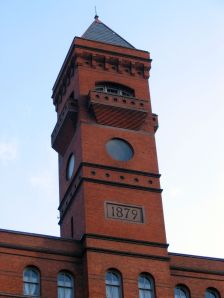Archive
I Learn Technology
I Learn Technology is an edublog published by Kelly Tenkely. The site provides information about instructional technology and electronic resources. It also includes posts that explain ways to integrate technology into the classroom. Tenkely is a former elementary school teacher, therefore most of the resources are intended for students in grades K-5. However, middle and high school teachers will find some suitable resources as well.
On the blog, Tenkely publishes a collection of I Learn “e-zines” that contain articles related to educational technology. The first issue presents information on mobile learning and features articles on podcasting, Apple iPod learning labs, and features of the various types of iPods. The e-zine also contains numerous links to websites appropriate for students of all ages, including iTunesU which features K-12 educational podcasts. The second issue includes articles on topics such as choosing an iPod for your classroom, computer lab management, and how-to’s for mobile learning. One section presents information related to iPhone apps, categorized by subject. Many of the apps can be used with any grade level, from kindergarten to high school.
Grammaropolis is a fun educational site designed for early elementary students. Tenkely’s Grammaropolis post describes the many features of the site. Grammaropolis includes animated books that feature the parts of speech as characters in an illustrated story. Additional activities include a song, videos, games, and quizzes. All of the content related to the Noun is free. All other characters include an animated description and a free book. Teachers can purchase a Grammaropolis passport for a small monthly or annual subscription fee. The passport unlocks music, videos, quizzes, and games for all of the other characters.
Kathy Schrock’s Guide for Educators
Kathy Schrock’s Guide for Educators is a categorized list of websites that can be used for instructional planning and professional growth. The site is frequently updated to include new sites for teaching and learning. In the “Subject Access” section of the site, you will find a list of links to subject areas. Clicking a subject area link provides access to a list of resources that can be used for developing classroom activities.
By clicking on the Weather Info and Maps link in the “Subject Access” section, I found a list of weather-related links. The Intellicast site provided six interactive weather maps. The Local Weather Report provided current conditions, 10-day forecast; times of sunrise/sunset and moonrise/moonset; moon phases; wind direction and speed. Additional links provided an interactive weather map, hourly forecast, historic averages, past observations, and more. This site would be an excellent resource for a science unit on weather and could be adapted for use at all grade levels.
Another link in this category directed to NOAA Education Resources. This site provided a wealth of resource collections on topics such as hurricanes, weather observations, watersheds, flooding, and pollution, estuaries, ocean pollution, changing seasons, the Gulf oil spill, and many more! Each link presented information related to the topic, along with links to additional resources. This site would be appropriate for science students in grades 6 and above.
The image above depicts storm clouds over the Brittany coast in France.
Creative Commons
 Copyright laws were implemented long before the Internet existed and can cause difficulty when teachers (and others) wish to use web-based resources. Creative Commons is an organization with the mission to provide the means for creators to maintain copyright while allowing limited use of their work. Creative Commons provides various licensing options that might be used by teachers who are looking for a simple way to license educational works such as lesson plans and instructional materials.
Copyright laws were implemented long before the Internet existed and can cause difficulty when teachers (and others) wish to use web-based resources. Creative Commons is an organization with the mission to provide the means for creators to maintain copyright while allowing limited use of their work. Creative Commons provides various licensing options that might be used by teachers who are looking for a simple way to license educational works such as lesson plans and instructional materials.
Works published under Creative Commons licensing are an excellent source of content for classroom use. Many works are available at no charge, with the simple requirement that the original creator be given credit. The Creative Commons Search provides an easy way for teachers to search for media, videos, photos, and music published under Creative Commons licensing. The search tool provides access to nearly unlimited resources that can be used for lessons, instructional materials, presentations, and student projects.
Free Digital Photos
Teachers sometimes have difficulty finding copyright-free resources that can be used for presentations and learning projects. In my classes, I teach students about issues of plagiarism and copyright, and I am careful to follow copyright laws in classroom assignments and presentations. Because copyright law is not always clear-cut, I take care to avoid copyright violations and to model appropriate use of resources for my students. In my search for digital resources for use in presentations, I found two excellent articles with many links to free digital images.
Digital Image Magazine has published two articles, “25 Free Stock Photo Sites” and “18 More Free Stock Photo Sites”, that provide links to free digital photo sites. Many photos from these sites can be legally downloaded free of charge. Others are available for a small fee. Make sure that you read the requirements for legal use of the images, as most require that you give credit to the artist.
I was pleased to see that one of my favorite photo resource sites, Free Digital Photos, was included in the second article. The site is easy to navigate and includes free low-resolution images that are appropriate for websites. Downloaded photos are not watermarked, and each photo download page provides a link to HTML code that can be used to publish a credit. The site has a variety of images and illustrations that are arranged in easy-to-browse categories. The site search engine makes it possible to easily search for images by keyword as well. Many of the images used on this blog are available from Free Digital Photos. No matter the topic, I’ve been able to find appropriate images that could be quickly downloaded.
Copyright and Fair Use
 Several years ago, a lawsuit against a 12 year old girl who downloaded copyrighted music started a wave of lawsuits against young people who break copyright laws. Headlines continue to make the news regarding cases of copyright infringement. The Recording Industry Artists Association (RIAA) is suing students, and universities are imposing penalties on students in an effort to avoid potential lawsuits. In today’s classroom, attention to copyright is imperative, and students must be taught by example the importance of adhering to copyright laws.
Several years ago, a lawsuit against a 12 year old girl who downloaded copyrighted music started a wave of lawsuits against young people who break copyright laws. Headlines continue to make the news regarding cases of copyright infringement. The Recording Industry Artists Association (RIAA) is suing students, and universities are imposing penalties on students in an effort to avoid potential lawsuits. In today’s classroom, attention to copyright is imperative, and students must be taught by example the importance of adhering to copyright laws.
Stanford University Law School provides resources on the use of copyrighted works under fair use guidelines. A copyright overview explains the basics of copyright law, what is protected, how to get permission to use copyrighted works, website and educational permissions, and an explanation of fair use. The Center for Internet and Society (CIS) at Stanford Law School presents cases related to copyright infringement and links to experts on copyright law.
According to the CIS website:
“The Fair Use Project (FUP) is the only organization in the country dedicated specifically to providing free and comprehensive legal representation to authors, filmmakers, artists, musicians and other content creators who face unmerited copyright claims, or other improper restrictions on their expressive interests. The FUP has litigated important cases across the country, and in the Supreme Court of the United States, and worked with scores of filmmakers and other content creators to secure the unimpeded release of their work.”
Information from these sites may be used by educators who wish to learn more about copyright. The cases related to copyright infringement could be used to develop cases studies for high school students in technology or language arts courses to learn about copyright. The cases could also be used as the basis of class discussions or to generate ideas for classroom debates.
The Copyright Site is another great resource for educators. It provides information and instructional resources for all grade levels. Of particular interest to teachers are links to copyright myths and copyright scenarios that can be used in the classroom, and teaching ideas for all ages, from kindergarten to college.
The Teaching Copyright site published by The Electronic Frontier Foundation (EFF) provides additional excellent curriculum resources. A copyright curriculum and links to additional copyright resources are presented on the site.
Discovery Education
Discovery Education provides free educational resources such as lesson plans, interactive games, puzzles, and other instructional content. Resources can be searched by grade or by subject. One helpful resource from this site is Science Fair Central. Students can use this resource to find a science fair topic or to plan a science fair presentation. Science Fair Central includes presentation how-to’s, sample judge’s scoring sheet, a timeline for completing the presentation, and a checklist to be used to evaluate the presentation board prior to submission. Additional content, including educational videos from United Streaming, is available for teachers in school districts with paid subscriptions to the site. Check with your principal or district technology coordinator for login information.
Cool Cat Teacher
At Cool Cat Teacher, Vicki Davis presents information about the many ways that she uses technology in the classroom. Her site includes technology tutorials, teaching tips, education-related news, and links to sites that can be used in the classroom. Davis sponsors “Flat Classroom Projects” that provide opportunities for global collaboration between classrooms at all grade levels. Davis explained that “The concept of a ‘flat classroom’ is based on the constructivist principle of a multi-modal learning environment that is student-centered and a level playing field for teacher to student and student to teacher interaction.” In the article, Digital Citizenship, Davis and Lindsay (2010) provide an overview of The Flat Classroom project, and explain the opportunities included in the project. Another article published by the pair, Flat Classrooms, describes the origin of the project.
Davis provided an excellent explanation of the ways that she used wikis for instruction. Students uploaded lesson summaries that contained vocabulary words and lesson concepts. They could access the content for at-home study. They also posted collaborative notes and created information wikis to explore new topics. She described a project in which students reached beyond the classroom walls to share important information about Internet safety. She also used the wiki for authentic assessments that replaced exams. For one assessment, students selected computer equipment for a family member and made recommendations regarding computer specifications to meet his needs. Another entry showcased a project in which students created virtual “study halls” for various school subjects. In her entry, Davis described the excitement generated by the project.
Davis’ suggestions for using wikis in the classroom could be used in a multitude of ways for almost any subject and grade level. For example, in a secondary business classroom, students might create sample business documents such as cover letters and resumes and post them to a class wiki. Students could also post notes related to the job application process and include information related to job interview skills. A class wiki would be an ideal place to post pictures of appropriate professional dress and to share other relevant information so that the entire class would have access to relevant resources.
Smithsonian Education
Smithsonian Education provides numerous teaching resources related to a variety of topics. The site’s search engine can be used to locate activities by category, subject and grade level, or by state learning standards. In the category of Science & Technology, I discovered a lesson on podcasting. The activity provided an overview of podcasting, and then described an instructional activity in which 3rd-grade students from Arlington, Virginia, converted reports on the national monuments into a multimedia narrative history of the nation’s capital. After describing the class activity, the site provided links to resources for creating podcasts and then explained how to edit and distribute podcasts. Additional podcasting resources were provided.
Although this activity was designed for elementary students, it could be easily adapted for a high school class in history, technology, or English. Podcasts might be used for a formative assessment to determine what students learned on a field trip or to present a guided tour of local attractions or places of historical or cultural interest.
Image: Lance Smith | Agency: Dreamstime.com
The image above depicts the old Smithsonian building in Washington, D.C.
e-Pals Global Learning Community
The e-Pals Global Learning Community is a safe social learning platform that can be used in K12 classrooms for communication and collaboration with classes around the world. The site allows teachers to link their classrooms with others for the purpose of engaging in collaborative educational projects. The project database can be searched by classroom profiles, country, by project, or by perusing teacher forums. All projects are linked with national standards.
The Digital Storytelling Classroom Project is featured on the e-Pals Projects for Collaboration page. The Project Overview explains that students will learn about the ancient practice of storytelling and then tell a story using modern technology tools. They will participate in an email exchange to discuss the process as they develop a story topic, write a story, create or find appropriate images, and share and reflect on their story. The project includes the following components: Essential Questions, Objectives, Culminating Activity, Project Elements, and National Standards.
This project would be appropriate for a variety of classes and could be adapted for any grade level. A look at the Digital Storytelling Teacher Forum reveals a range of classes from first grade through high school who would like to collaborate on this project for history, African American Studies, and language arts. In a middle school technology classroom, this might be implemented as an integrated project to include objectives from American History, language arts and technology. Students could interview World War II veterans and record their stories using technology tools. It might be interesting to partner with a classroom in Japan or Hawaii and compare stories from the perspectives of residents of those areas.
Image: Ken Cole | Agency: Dreamstime.com
The image above depicts part of the Second World War Memorial in Washington, DC
The Learning Network
The Learning Network, hosted by the New York Times, posts a new lesson plan each weekday. Lessons are aligned with McRel national standards. You can sign up to receive plans via email each day or choose to receive them on specified days. Students may respond to a daily student opinion question, answer “Test Yourself” questions that are related to math and language arts, or learn what happened “on this day” in history.
When I taught secondary business technology, current event presentations were frequently used in my classroom. Each week, I selected an article to share with students or had them find relevant articles to share with the class. The Learning Network presents an innovative lesson in which students work in teams to annotate news articles using technology tools such as Wikispaces, SoundCloud, Tout, or VoiceThread. Annotations may include definitions of terms, related articles, videos, biographical information for people mentioned in the article, maps, or graphics. The article suggests that in a classroom without computers, the activity could be modified so that students create a poster that displays the article with hand-written annotations. This activity is an excellent way to actively engage students in reading the news.







